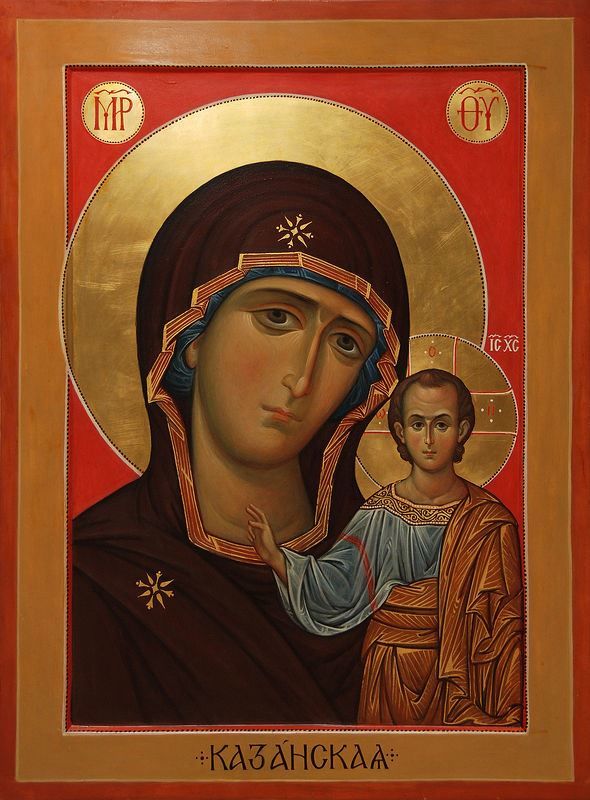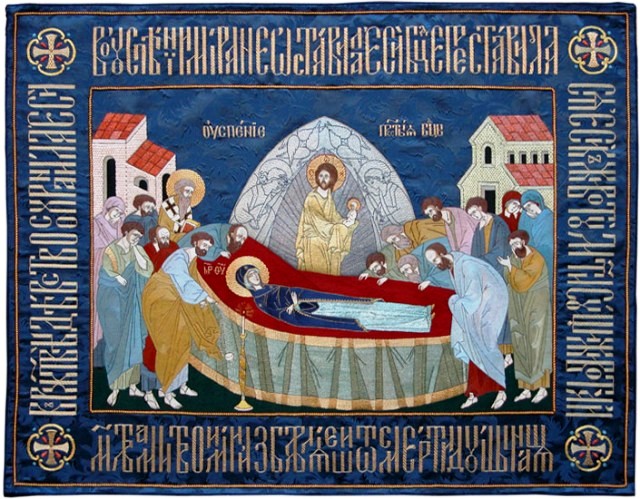Dear brothers and sisters, festal greetings to you all, as we celebrate the autumn feast of the Kazan Icon of the Most Holy Mother of God.
The Russian Orthodox Church celebrates some three-hundred ‘revealed’ icons of the Mother of God, among which we find the Kazan Icon of the Most Holy Theotokos, in whose name our parish is dedicated.

Throughout the centuries of Muscovite and Imperial Russia, just as so many icons of the Theotokos have been revealed in miraculous circumstances, so the Mother of God has revealed and manifested her maternal care and protection for the Orthodox faithful and the lands of Rus – through her icons, through her miraculous intercession, and through her countless miracles worked in the lives of ordinary people.
On the very day of the Tsar’s abdication, the Mother of God renewed her “Reigning/Derzhavnaya” icon, showing that for the faithful, she would now take upon her shoulders the role of Tsaritsa of the Russian realm, leading the faithful through the torment and torture of the Soviet period, and throughout those dark years her maternal-care continued to be felt. And, during those torturous years, the faithful were never left without the consolation of the Mother of God.
Together with the Icon of the Sign, and the Vladimirskaya, the Wonderworking Kazan Icon is one of the ‘Palladium’ icons, carried by the faithful into battle and defence of the realm, and today’s feast commemorates the defeat of the Poles, in the Time of Troubles (after the death of Ivan the Terrible) and the first significant defeat of the Napoleonic army, after snow and ice lashed the invading French forces. Such was the faith of believing people even in Soviet times, that we have the well-known description of a copy of our beloved Kazan Icon being carried around besieged Leningrad during the Second World War.
Yet, despite the miraculous victories and the martial hymns to the Mother of God as “Triumphal leader in battle”, for Russian Orthodox believers the Theotokos is not so much impressed upon our spiritual consciousness as Heavenly Empress, but as the merciful Mother of Christians, who cares for the faithful, nurturing them, providing for them in their hour of need, bringing joy in sorrow, becoming a hope for the hopeless and help for the helpless.
This always strikes me whenever we sing the beautiful hymn, Царице моя преблагая (Tsaristsa moya preblagaya), to the beautiful yet very simple melody from the Krasnogorsk Monastery,
O my most blessed Queen, O Theotokos my hope, guardian of orphans and intercessor for strangers, Joy of the sorrowful, Protectress of the oppressed; Thou beholdest my misfortune, Thou seest my sorrow. Help me, for I am infirm; feed me, for I am a stranger. Thou knowest mine offense: do Thou loose it, as Thou dost will, for I have none other help but Thee, nor any other intercessor save Thee, O Mother of God. Do Thou preserve and protect me unto the ages of ages. Amen.
Behind this present feast’s triumphal language, and images of victory in which we speak of the Mother of God as Lady, Queen and Mistress and her ‘mighty protection’, this celebration leads us to the tenderness and warmth of the motherhood of the Theotokos – summed up by that wonderful word umilinie – which is tenderness, compassion, mercy, loving-kindness, warmth, with so many other subtle shades of meaning when applied to the motherhood of the Mother of God.
As we look at the Kazan Icon, there is nothing complicated, and its scheme is in many ways minimal, simple and straightforward, and it has traditionally been this icon that has been carried before newly-weds, to become the heart of the icon-corner in each new home, at the centre of Orthodox family-life.
In the classic Hodegetria icon, the Mother of God directs us to her Son with her outstretched hand, but in the Kazan Icon she rather does so in the inclination of her head, as she bows contemplatively towards the Christ-Child, avoiding the eyes of the viewer, so that it is the Saviour who engages with the one who stands before the icon, and it is His eyes they meet, not the self-effacing and humble Mother.
As she ever leads us to her Son, ever interceding for us, before the Holy Trinity, let us never be strangers to her maternal care, however broken or dysfunctional our lives may have become. Rather, let us turn to her with all of our problems and sorrows, as well as our joys, bringing our lives, ourselves, our loved ones, our friends, even enemies to her merciful-care. It is beneath that merciful-care, that reconciliation, forgiveness, and healing may happen, through her prayers, through her grace, and with her help.
It is often in the most grievous of sorrows, and the most desperate situations that we learn the value, the wholesomeness and necessity of a Mother’s love, and in the Mother of God we find maternal care that never ceases, that never dies, but always seeks out those in need, to lead us to the Saviour in His Kingdom, into which she has been assumed in glory.
On this feast, let us do as the deacon calls us to do during the litanies:
“Commemorating our most holy, most pure, most blessed and glorious Lady, the Theotokos and ever-virgin Mary with all the saints, let us commit ourselves and one other, and all our life unto Christ our God.”
Most Holy Theotokos, save us!
Asking your prayers, with love in Christ.
Hieromonk Mark





